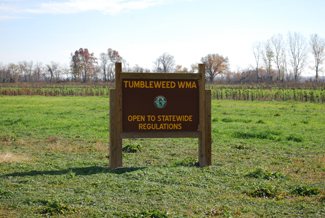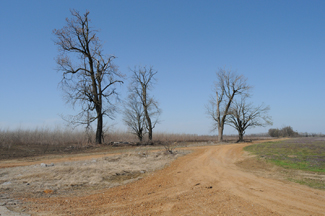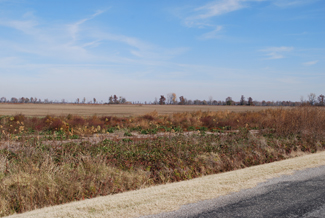Tumbleweed WMA
Site Directions: From Hwy 78 south of Ridgely, go west on Hwy 79 to intersection with 181, which actually goes straight. Turn right on Hwy 79 West and go approximately 150m to a left turn over a levee. Follow the paved road over the levee and go 2.4 miles to eastern corner of the WMA at a small parking lot and a small number of large trees. The road is poorly maintained and ends within walking distance of the Mississippi River.
A new part of Tumbleweed WMA is accessible from the Great River Rd (Hwy 181) at Parker Rd. Parker road has WMA on both sides of the road. From the intersection of Parker Rd and Owl Hoot Rd (lat-long below), travel south on Owl Hoot Rd to get to the south side of the WMA.
Lat-Long: 36.22195, -89.58578, on Hwy 79 where the WMA begins (west side of the Great River Rd)
Lat-Long: 36.198573,-89.534926, interesection of Parker Rd and Owl Hoot Rd
Hours: daylight hours.
Seasonality: year round, access dependent on hunting seasons.

Sign on Parker Rd.on east unit of the WMA.
Site Description: The area contains 1,872 acres of early successional forests planted by TWRA. TWRA has recently (from 2010-2012) obtained a couple thousand more acres on the east side of the Great River Rd accessed via Parker Rd and Owl Hoot Road. The new areas are recently reforested, currently grassland/shrubland, while some areas are still farmed. Some areas hold water after heavy rains and floods and may be decent shorebird habitat.

Eastern edge of the western unit of the WMA on Hwy 79, west of the Great Rver Rd. There are hundreds of acres of young forest and open field in this area.
Wildlife to Watch: This area is filled with birds, particularly during the spring migration period. Due to the presence of grassland habitats on the sandy soils of some of the area, grassland species such as the Grasshopper Sparrow, may be encountered. Numerous Warbling Vireos and orioles have been noted in the spring. Northern Harriers frequent the fields around Tumbleweed WMA in winter. Red-tailed Hawks are seen frequently in the area.
The new units had significant shorebird numbers after the 2011 flood. Over 100 White-rumped Sandpipers and hundreds of Pectoral Sandpipers, along with Black-bellied Plovers and other shorebirds were present in late May. Large numbers of Great Egrets and other wading birds may be present. Cattle Egret are occasional. Short-eared Owls should be present in winter.

Fallow field and bare ground along Parker Rd. This area supports shorebirds and wading birds when wet and in season. Larks, pipets, longspurs, killdeer, and harriers are often present in winter.
NOTE: Please refer to TWRA Hunting Guide about hunting seasons and public access dates. Access dates vary by site.
For more information:
Submit your data to eBird and help us build a list of birds seen at this site.
Be sure to check out our Safety Tips page for important information regarding viewing wildlife in these areas.



